March 26 - April 1 2023: Issue 577
Urgent Climate Action Can Secure A Liveable Future For All: 2023 IPPC 'Synthesis Report'
INTERLAKEN, Switzerland, March 20, 2023
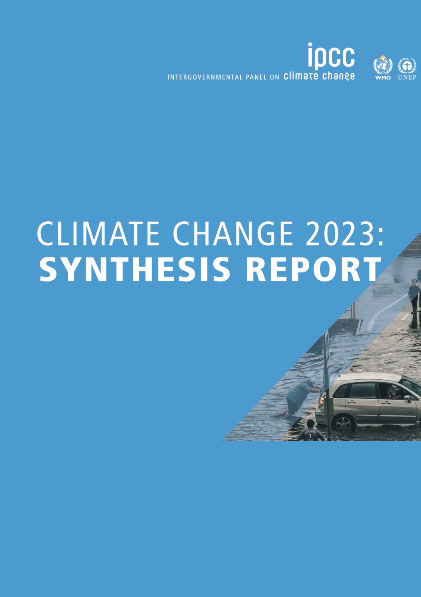 There are multiple, feasible and effective options to reduce greenhouse gas emissions and adapt to human-caused climate change, and they are available now, said scientists in the latest Intergovernmental Panel on Climate Change (IPCC) report released today.
There are multiple, feasible and effective options to reduce greenhouse gas emissions and adapt to human-caused climate change, and they are available now, said scientists in the latest Intergovernmental Panel on Climate Change (IPCC) report released today.
“Mainstreaming effective and equitable climate action will not only reduce losses and damages for nature and people, it will also provide wider benefits,” said IPCC Chair Hoesung Lee. “This Synthesis Report underscores the urgency of taking more ambitious action and shows that, if we act now, we can still secure a liveable sustainable future for all.”
In 2018, IPCC highlighted the unprecedented scale of the challenge required to keep warming to 1.5°C. Five years later, that challenge has become even greater due to a continued increase in greenhouse gas emissions. The pace and scale of what has been done so far, and current plans, are insufficient to tackle climate change.
More than a century of burning fossil fuels as well as unequal and unsustainable energy and land use has led to global warming of 1.1°C above pre-industrial levels. This has resulted in more frequent and more intense extreme weather events that have caused increasingly dangerous impacts on nature and people in every region of the world.
Every increment of warming results in rapidly escalating hazards. More intense heatwaves, heavier rainfall and other weather extremes further increase risks for human health and ecosystems. In every region, people are dying from extreme heat. Climate-driven food and water insecurity is expected to increase with increased warming. When the risks combine with other adverse events, such as pandemics or conflicts, they become even more difficult to manage.
Losses and damages in sharp focus
The report, approved during a week-long session in Interlaken, brings in to sharp focus the losses and damages we are already experiencing and will continue into the future, hitting the most vulnerable people and ecosystems especially hard. Taking the right action now could result in the transformational change essential for a sustainable, equitable world.
“Climate justice is crucial because those who have contributed least to climate change are being disproportionately affected,” said Aditi Mukherji, one of the 93 authors of this Synthesis Report, the closing chapter of the Panel’s sixth assessment.
“Almost half of the world’s population lives in regions that are highly vulnerable to climate change. In the last decade, deaths from floods, droughts and storms were 15 times higher in highly vulnerable regions,“ she added.
In this decade, accelerated action to adapt to climate change is essential to close the gap between existing adaptation and what is needed. Meanwhile, keeping warming to 1.5°C above pre-industrial levels requires deep, rapid and sustained greenhouse gas emissions reductions in all sectors. Emissions should be decreasing by now and will need to be cut by almost half by 2030, if warming is to be limited to 1.5°C.
Clear way ahead
The solution lies in climate resilient development. This involves integrating measures to adapt to climate change with actions to reduce or avoid greenhouse gas emissions in ways that provide wider benefits.
For example: access to clean energy and technologies improves health, especially for women and children; low-carbon electrification, walking, cycling and public transport enhance air quality, improve health, employment opportunities and deliver equity. The economic benefits for people’s health from air quality improvements alone would be roughly the same, or possibly even larger than the costs of reducing or avoiding emissions.
Climate resilient development becomes progressively more challenging with every increment of warming. This is why the choices made in the next few years will play a critical role in deciding our future and that of generations to come.
To be effective, these choices need to be rooted in our diverse values, worldviews and knowledges, including scientific knowledge, Indigenous Knowledge and local knowledge. This approach will facilitate climate resilient development and allow locally appropriate, socially acceptable solutions.
“The greatest gains in wellbeing could come from prioritizing climate risk reduction for low-income and marginalised communities, including people living in informal settlements,” said Christopher Trisos, one of the report’s authors. “Accelerated climate action will only come about if there is a many-fold increase in finance. Insufficient and misaligned finance is holding back progress.”
Enabling sustainable development
There is sufficient global capital to rapidly reduce greenhouse gas emissions if existing barriers are reduced. Increasing finance to climate investments is important to achieve global climate goals. Governments, through public funding and clear signals to investors, are key in reducing these barriers. Investors, central banks and financial regulators can also play their part.
There are tried and tested policy measures that can work to achieve deep emissions reductions and climate resilience if they are scaled up and applied more widely. Political commitment, coordinated policies, international cooperation, ecosystem stewardship and inclusive governance are all important for effective and equitable climate action.
If technology, know-how and suitable policy measures are shared, and adequate finance is made available now, every community can reduce or avoid carbon-intensive consumption. At the same time, with significant investment in adaptation, we can avert rising risks, especially for vulnerable groups and regions.
Climate, ecosystems and society are interconnected. Effective and equitable conservation of approximately 30-50% of the Earth’s land, freshwater and ocean will help ensure a healthy planet. Urban areas offer a global scale opportunity for ambitious climate action that contributes to sustainable development.
Changes in the food sector, electricity, transport, industry, buildings and land-use can reduce greenhouse gas emissions. At the same time, they can make it easier for people to lead low-carbon lifestyles, which will also improve health and wellbeing. A better understanding of the consequences of overconsumption can help people make more informed choices.
“Transformational changes are more likely to succeed where there is trust, where everyone works together to prioritise risk reduction, and where benefits and burdens are shared equitably,” Lee said. “We live in a diverse world in which everyone has different responsibilities and different opportunities to bring about change. Some can do a lot while others will need support to help them manage the change.”
AR6 Synthesis Report: Climate Change 2023
The IPCC finalised the Synthesis Report for the Sixth Assessment Report during the Panel's 58th Session held in Interlaken, Switzerland from 13 - 19 March 2023.
‘It can be done. It must be done’: IPCC delivers definitive report on climate change, and where to now
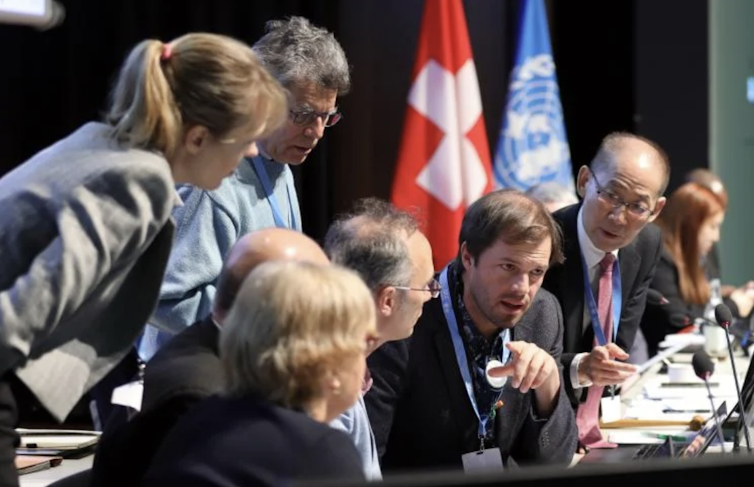
The world is in deep trouble on climate change, but if we really put our shoulder to the wheel we can turn things around. Loosely, that’s the essence of today’s report by the Intergovernmental Panel on Climate Change (IPCC).
The IPCC is the world’s official body for assessment of climate change. The panel has just released its Synthesis Report, capping off seven years of in-depth assessments on various topics.
The report draws out the key insights from six previous reports, written by hundreds of expert authors. They spanned many thousands of pages and were informed by hundreds of thousands of comments by governments and the scientific community.
The synthesis report confirms humans are unequivocally increasing greenhouse gas emissions to record levels. Global temperatures are now 1.1℃ above pre-industrial levels. They’re likely to reach 1.5℃ above pre-industrial levels in the early 2030s.
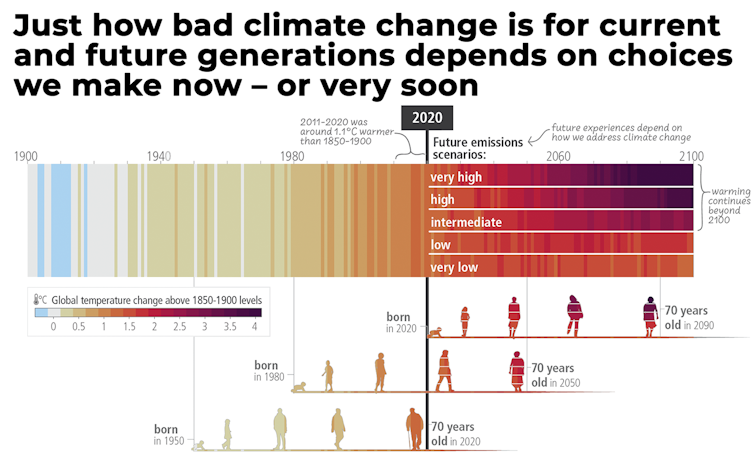
This warming has driven widespread and rapid global changes, including sea level rise and climate extremes – resulting in widespread harm to lives, livelihoods and natural systems.
It’s increasingly clear that vulnerable people in developing countries – who have generally contributed little to greenhouse gas emissions – are often disproportionately affected by climate change.
Intergenerational inequities are also likely. A child born now is likely to suffer, on average, several times as many climate extreme events in their lifetime as their grandparents did.
The world is up the proverbial creek - but we still have a paddle. Climate change is worsening, but we have the means to act.
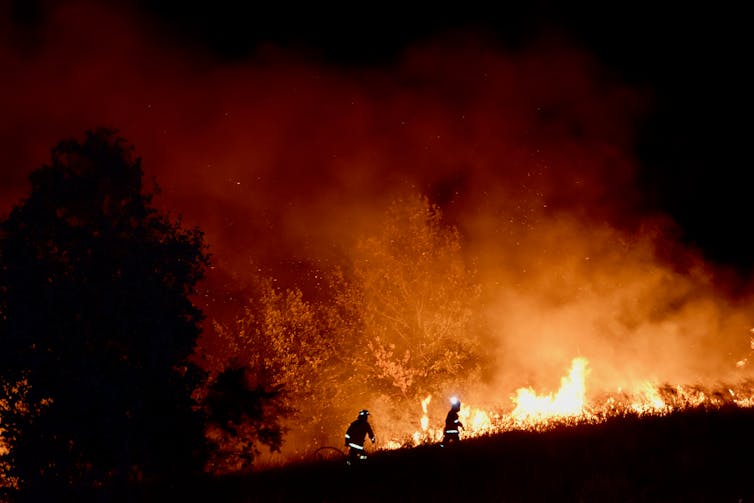
So Much At Stake
Over the past week in Interlaken, Switzerland, several hundred representatives from most of the world’s governments scrutinised the IPCC report’s 35-page summary. The scrutiny happens sentence by sentence, often word by word, and number by number. Sometimes it’s subject to intense debate.
We were both involved in this process. The role of the reports’ authors and IPCC bureau members is to stay true to the underlying science and chart a way between different governments’ preferences. It is a unique process for scientific documents.
The approval process usually goes right to the wire, in meetings running through the night. This Synthesis Report was no exception. The scheduled time for the meeting was extended by two days and nights, wearing down government representatives and the IPCC teams.
The process reflects how much is at stake. The IPCC’s assessments are formally adopted by all governments of the world. That in turn reverberates in the private sector – for example, in the decisions of boards of major companies and investment funds.

The Latest On Greenhouse Gas Emissions
The Synthesis Report confirms both emissions and atmospheric concentrations of greenhouse gases are now at record highs.
To keep warming within 2℃ above pre-industrial levels, global greenhouse gas emissions must decline by around 21% by 2030 and around 35% by 2035. Keeping warming below 1.5℃ requires even stronger emissions reduction.
This is a very tall order in light of emissions trajectories to date. Annual global emissions in 2019 were 12% higher than in 2010, and 54% higher than in 1990.
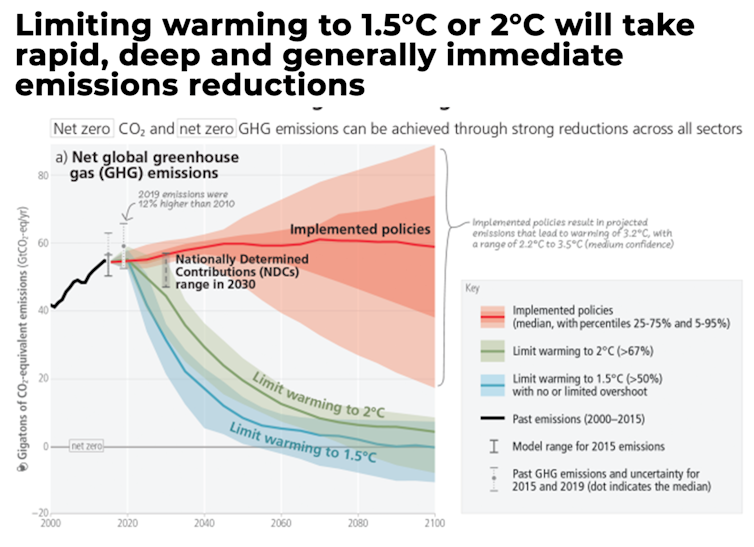
But success in reducing emissions has been demonstrated. The IPCC says existing policies, laws, technologies and measures the world over are already reducing emissions by several billion tonnes of carbon dioxide and other greenhouse gases, compared to what would otherwise be the case.
Most importantly, it’s clear global emissions could be reduced deeply if existing policy instruments were scaled up and applied broadly. The report shows large potential for emissions-reduction options across all parts of the world economy.
Many of these come at low cost. And many bring side benefits, such as reduced air pollution. If all technically available options were used, global emissions could be at least halved by 2030, at manageable costs.
As today’s report states, the global economic benefit of limiting warming to 2℃ exceeds the costs of emissions reduction. That’s without even taking into account the avoided damages of climate change or the side benefits that sensible action could generate.
We have the collective experience to turn the corner. As the report spells out, a great many regulatory and economic policy instruments have been used successfully. And we know how to design climate policies to make sure they’re politically acceptable and do not disadvantage the poorer parts of society.
The report also draws out the importance of good institutions for climate change governance – such as laws and independent bodies – and for all groups in society to be meaningfully involved.
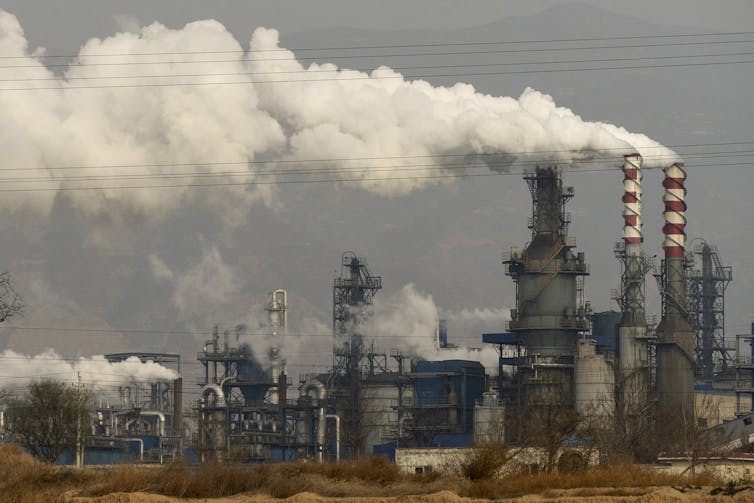
Adaptation Falls Short
Rapid action on climate change is the economically sensible thing to do. If we fail to rein in emissions, adapting to the damage it causes will be more difficult and expensive in future. What’s more, our existing adaptation options will become less effective.
Every increment of warming will intensify climate-related hazards such as floods, droughts, heatwaves, fires and cyclones. Often, two or more hazards will occur at the same time.
Unfortunately, overall global adaptation has not kept up with the pace and degree of increasing impacts from climate change. Most responses have been fragmented, incremental and confined to a specific sector of the economy. And most are unequally distributed across regions and vary in their effectiveness.
The barriers to more effective adaptation responses are well-known. Chief among them is a widening gap between costs of adaptation and allocated finance. We can, and should, do a lot better.
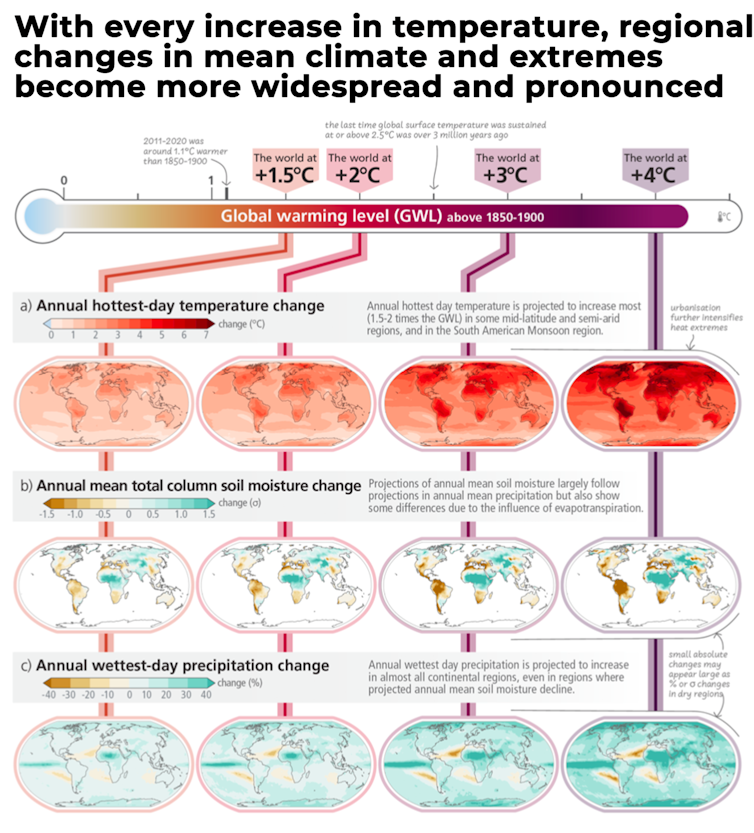
As today’s IPCC report confirms, there are ways to make adaptation more effective. More investment in research and development is needed. So too is a focus on long-term planning as well as inclusive, equitable approaches that bring together diverse knowledge.
Many adaptation options bring significant side benefits. Better home insulation, for instance, can help us deal with extreme weather as well as reduce heating and cooling costs and related greenhouse gas emissions.
Moving people off flood-prone areas and returning these areas to more natural systems can reduce flood risk, increase biodiversity and store carbon dioxide in plants and soil.
And climate adaptation policies that prioritise social justice, equity and a “just transition” can also help achieve other global ambitions, such as the United Nations Sustainable Development Goals.
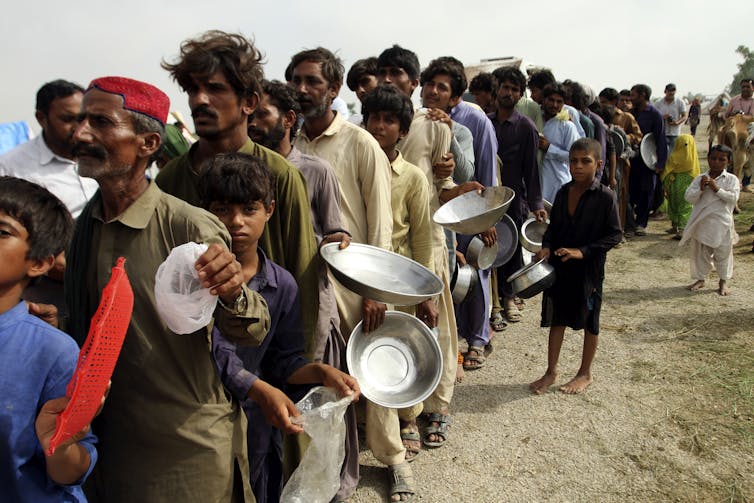
We Can Close The Gap
On both climate change mitigation and adaptation, a massive gap remains between what’s needed and what’s being done.
Countries’ current climate commitments do not add up to the shared ambition to keep temperature rise to below 2℃. And for many countries, current trajectories of emissions would also overshoot their targets.
What’s more, current total investments in low-emissions technology and systems is three to six times lower than what would be needed to keep temperatures to 1.5℃ or 2℃, according to modelling.
Likewise, on the whole not nearly enough effort is being made to understand, prepare and implement measures to adapt to climate changes. The gaps are generally biggest in developing countries, which can much less afford to invest in climate change action than rich parts of the world.
Developing countries are calling for large-scale climate finance to be provided by developed countries, and this is not happening to anywhere near the extent needed.
Predictably, issues of international equity and justice were among the thorniest in the approval of the Synthesis Report. The final version of the report frames the issue not as an irresolvable conflict, but as the opportunity for “shifting development pathways towards sustainability”.
The vision of most governments is for all the world to attain high standards of living, but to do so with “climate neutral” technologies, systems and patterns of consumption. And systems must be built so they’re robust to future climate change, including the nasty surprises that may come.
It must be done. It can be done. By and large, we know how to do it – and it makes economic sense to do so. In this report, the governments of the world have acknowledged as much.
Frank Jotzo is a Lead Author of the IPCC’s latest assessment report on climate change mitigation and member of the core writing team for the Synthesis Report. Mark Howden is a Vice Chair of the IPCC Working Group on climate impacts and adaptation and a Review Editor of the synthesis report. Both were involved in the government approval session for the IPCC Synthesis Report.
Fear & Wonder is a new climate podcast, brought to you by The Conversation. It will take you inside the IPCC’s era-defining climate report via the hearts and minds of the scientists who wrote it. The first episode drops on March 23. Learn more here, or subscribe on your favourite podcast app via the icons above.![]()
Frank Jotzo, Professor, Crawford School of Public Policy and Head of Energy, Institute for Climate Energy and Disaster Solutions, Australian National University and Mark Howden, Director, ANU Institute for Climate, Energy and Disaster Solutions, Australian National University
This article is republished from The Conversation under a Creative Commons license. Read the original article.
IPCC report: the world must cut emissions and urgently adapt to the new climate realities
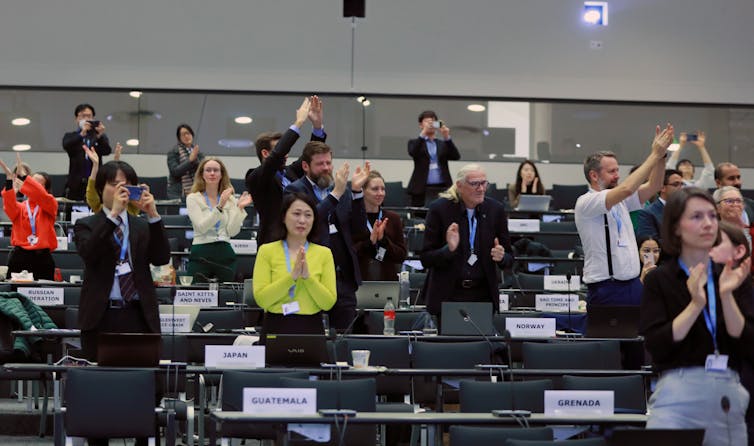
This decade is the critical moment for making deep, rapid cuts to emissions, and acting to protect people from dangerous climate impacts we can no longer avoid, according to the latest report by the Intergovernmental Panel on Climate Change (IPCC).
The synthesis report is the culmination of seven years of global and in-depth assessments of various aspects of climate change.
It reiterates that the world is now about 1.1℃ warmer than during pre-industrial times. This already results in more frequent and more intense extreme weather, causing complex disruption and suffering for communities worldwide. Many are woefully unprepared.
The report stresses our current pace and scale of action are insufficient to reduce rising global temperatures and secure a liveable future for all. But it also highlights that we already have many feasible and effective options to cut emissions and better protect communities if we act now.
Many countries have already achieved and maintained significant emissions reductions for more than ten years. Overall, however, global emissions are up by 12% on 2010 and 54% higher than in 1990. The largest rise comes from carbon dioxide (from the burning of fossil fuels and industrial processes), followed by methane.
The world is expected to cross the 1.5℃ temperature threshold during the 2030s (at the current level of action). Already, the effects of climate change are not linear and every increment of warming will bring rapidly escalating hazards, exacerbating more intense heatwaves and floods, ocean warming and coastal inundation. These complex events are particularly severe for children, the elderly, Indigenous and local communities, and disabled people.
But in agreeing to this report, governments have now recognised that human rights and questions of equity, loss and damage are central to effective climate action.
This report also breaks emissions down to households – 10% of the highest-emitting households contribute 40-45% of global greenhouse gas emissions, while 50% of the lowest-emitting households (including small islands communities), contribute less than 15% of overall greenhouse gases.
Climate-Resilient Development
The report points to solutions for climate-resilient development, a process which integrates actions to reduce or avoid emissions with those to protect people to advance sustainability. Examples include health improvements that come from broadening access to clean energy and contribute to better air quality.
But the choices we make need to be locally relevant and socially acceptable. And they have to be made urgently, because our options for resilient action are progressively reduced with every increment of warming above 1.5℃.
This report is also significant for recognising the importance of Indigenous knowledge and local community insights to help advance ambitious climate planning and effective climate leadership.
Cities Can Make A Big Difference
Cities are key drivers of emissions. They generate around 70% of carbon dioxide emissions globally, and this is rising largely through transport systems relying on fossil fuels, building materials and household consumption.
But this also means urban spaces are where we can really exercise climate leadership. Decisions made at the level of local councils are going to be significant globally in terms of bringing national and global emissions down and protecting people.
Cities are sites for solutions where we can decarbonise transport and increase green spaces. While tackling climate risks can feel overwhelming, acting at the city level is a way communities can have more control over reducing emissions and where local action can really make a difference to our quality of life.
We know there is much more money flowing into mitigation than adaptation. But we have to do both now, and move beyond adaptation focused on physical protection (such as sea walls). We also need to be thinking really carefully about green infrastructure (trees and parks), low-carbon transport and social protection for communities, which includes income replacement, better healthcare, education and housing.
This report was particularly difficult to negotiate because we now live in a changed reality. More and more countries are experiencing very significant losses and damages. As countries face increasingly extreme weather events, the stakes are higher.
Governments everywhere, in my view as a political scientist, are now facing hard choices about how to protect their own national interests while also making significant efforts to tackle our global climate crisis. In negotiations, larger countries can dominate debate and it can take a long time to get to agreement. This puts enormous pressure on smaller nations, including Pacific delegations with fewer people and diplomatic resources. This is yet another reason to ensure action is inclusive, fair and equitable.
For authors of the IPCC core writing team, the past 18 months have been intense. We all felt significant responsibility to accurately summarise years of work, completed by hundreds of our global scientific colleagues, who contributed to six reports in this assessment cycle: on physical science, adaptation and vulnerability, mitigation, and special reports on land, global warming of 1.5℃, and ocean and cryosphere.
These reports show the choices we make in this decade will impact current and future generations, and the planet, now and for thousands of years.
Fear & Wonder is a new climate podcast, brought to you by The Conversation. It will take you inside the IPCC’s era-defining climate report via the hearts and minds of the scientists who wrote it. The first episode drops on March 23. Learn more here, or subscribe on your favourite podcast app via the icons above.![]()
Bronwyn Hayward, Professor of Politics, University of Canterbury
This article is republished from The Conversation under a Creative Commons license. Read the original article.